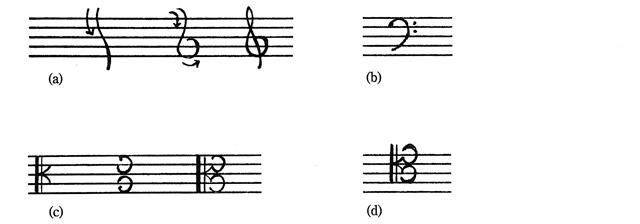Conventions of Notation
Computer applications that notate music are commonly used by arrangers, but no program is able to make all the correct choices about such parameter as beams, lyrics, and placement of diacritical markings. It is a great asset for the orchestrator to be able to present performers with proper music manuscript. To do so, one must learn the shape and placement of symbols in their conventional form. Students should constantly strive to improve the level of quality in their manuscript. A note head is an oval shape angled upwards to the right, not a slash or a round circle. A stem is three spaces, or one octave in length. The exception to this rule is that if the note is two or more ledger lines away from the staff, the stem is extended to the middle line of that staff. Guidelines and examples illustrating correct manuscript are provided here for reference.
FIGURE 1.7 How to draw (a) treble, (b) bass, (c) alto, and (d) tenor clefs
FIGURE 1.8 How to draw accidentals
FIGURE 1.9 Key signatures in (a) treble, (b) bass, (c) alto, and (d) tenor clefs
FIGURE 1.10 How to draw rests
Notice the shape of the quarter rest, which most copyists draw from the bottom upwards. The horizontal part of the eighth rest lies in the third space, and all dots following rests of any value are also placed in the third space. Multiple measures of rest in a part are indicated by a thick horizontal line on the third space of the measure with thin vertical lines on both ends. A large numeral showing the number of measures of rest is placed above the staff.
FIGURE 1.11 Chords with seconds and accidentals
The note farthest from the center of the staff determines the stem direction of a chord. Draw the note heads first, then connect them with a stem that extends at least two lines past the last note of the chord.
When drawing chords with the interval of a second, follow these steps:
- Determine the note farthest from the center of the staff, and write it.
- Add the stem in the proper direction.
- Moving away from the first written note, place the other notes along the stem on the correct side if possible.
The upper note will be placed on the right-hand side of the stem when the interval of a second occurs. The accidentals are added from top to bottom, moving from right to left, so that the top accidental is closest to the chord. If altered notes are placed along the stem at the interval of a seventh apart, then accidentals may be aligned vertically.
FIGURE 1.12 Beamed units and borrowed groupings
When a group of notes is to be beamed, the note farthest from the center of the staff determines whether the beam will be placed above or below the grouping. Beams follow the general contour of the notes, connecting the stems of the first and last notes of the grouping. If notes are more than one ledger line from the staff, the beam connecting them rests on the third line of the staff. All notes within a rhythmic unit, or metrical beat, should be beamed. However, beams may not extend between unit beat groupings. If there are rests within a group, do not extend multiple beams above or below the rest.
Borrowed groups, such as the triplet in 4/4 time, are designated by a number in the center of a bracket drawn over the note heads or the beam.
FIGURE 1.13 Vertical alignment of two parts
Exercise extreme care in aligning all beats in all parts of a score. This is probably the single most important factor affecting the ease with which a score can be interpreted.
FIGURE 1.14 Placement of slurs
Slurs ordinarily extend smoothly between note heads. They are placed outside staccato dots or tenuto dashes and inside percussive or pressure accents. A legato slur is generally placed over notes with stems pointing both up and down. If the last two notes under a slur are tied, extend the slur to the second note. When slurring two notes with different stem directions, slur over the top from note head to note head.
FIGURE 1.15 Placement of ties
Ties connect note heads of the same pitch. Notes above the center of the staff have ties curved above, and notes below the center have ties curved below.
FIGURE 1.16 Two parts sharing a staff
When two independent parts share a staff, seconds are written in reverse order, unless the voices cross, to give better stem placement. Slurs, articulations, and dynamics always appear nearest the part to which they apply. All markings for the upper part are place above it, and all markings for the lower part below.
Octave Terminology
One system of designating octaves is used consistently in this text. A simple way to remember it is to think of middle c as one-line c. It is notated as c1. The octave below is c; the octave above c1 is c2. All notes in the octave above each c have the same superscript numeric designation. Since MIDI technology has become common, a different octave designation is often used. Middle C (MIDI Note #64) is referred to as C4. The octave below is C3, the octave above is C5, and so on.
FIGURE 1.17 Octave terminology
The symbol “8va” is placed over a note or a passage that is to be played one octave higher, with a dotted line extending for the duration of the passage. The same designation is placed under a passage to be played an octave lower. The symbol “15ma” is used to indicate the distance of two octaves above or below the written pitch, from the Italian “quindicesima.”











